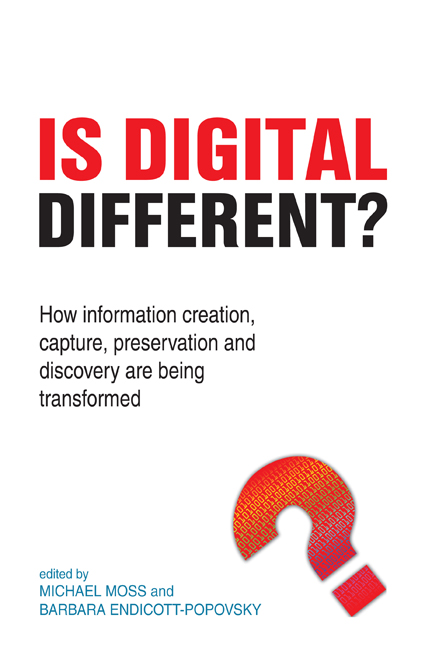 Is Digital Different?
Is Digital Different? Book contents
- Frontmatter
- Contents
- Contributors
- Introduction and acknowledgements
- 1 What is the same and what is different
- 2 Finding stuff
- 3 RDF, the Semantic Web, Jordan, Jordan and Jordan
- 4 Crowdsourcing
- 5 Pathways to integrating technical, legal and economic considerations in the design, development and deployment of trusted IM systems
- 6 Finding archived records in a digital age
- 7 Security: managing online risk
- 8 Rights and the commons: navigating the boundary between public and private knowledge spaces
- 9 From the Library of Alexandria to the Google Campus: has the digital changed the way we do research?
- Index
Introduction and acknowledgements
Published online by Cambridge University Press: 08 June 2018
- Frontmatter
- Contents
- Contributors
- Introduction and acknowledgements
- 1 What is the same and what is different
- 2 Finding stuff
- 3 RDF, the Semantic Web, Jordan, Jordan and Jordan
- 4 Crowdsourcing
- 5 Pathways to integrating technical, legal and economic considerations in the design, development and deployment of trusted IM systems
- 6 Finding archived records in a digital age
- 7 Security: managing online risk
- 8 Rights and the commons: navigating the boundary between public and private knowledge spaces
- 9 From the Library of Alexandria to the Google Campus: has the digital changed the way we do research?
- Index
Summary
The purpose of this book is to introduce students, particularly but not exclusively those on information studies programmes, to the issues surrounding the transition from an analogue to a digital environment. The contributors strip away much of the e-hype that surrounds the digital environment and focus on the opportunities and challenges afforded by this new environment that is transforming the information landscape in ways that were scarcely imaginable even a decade ago. Contributors examine whether analogue practices and procedure that are largely handicraft are still valid and if they shape or distort those in the digital, which can best be characterized as industrial and requiring engineering solutions.
By drawing on examples of the impact of other new and emerging technologies on the information sciences in the past, such as the printing press in the 15th century, the wet-copy process in the 18th century and the typewriter in the late 19th century, the book emphasizes that information systems have always been shaped by available technologies that have transformed the creation, capture, preservation and discovery of content. Whilst seeking to avoid techno-determinism, the contributions illustrate the ways in which the digital environment has the potential to transform scholarship across the disciplines at all levels, even if it has not done so yet, and to break down barriers between the academy and the wider community through social networks and crowdsourcing. There are analogies here with the way in which the reordering of libraries pioneered by Martin Schrettinger in the early 19th century helped to transform scholarly enterprise that came to be described in all disciplines as ‘scientific’.
From the different perspectives of each chapter the contributors explore the role, as they see it, of information professionals in this rapidly changing digital landscape, which is challenging the very existence of the traditional library and archive as more and more resources become available online and as computers and supporting networks become more and more powerful. Users expect to be able to work at their screens from home, however unrealistic this may seem to many traditional curators.
- Type
- Chapter
- Information
- Is Digital Different?How information creation, capture, preservation and discovery are being transformed, pp. xv - xviPublisher: FacetPrint publication year: 2015


